NORMDIST function - The function returns the normal distribution with the standard deviation and the average value specified in Excel
The following article details the NORMDIST function - The function returns the normal distribution in excel.
Description: The function returns the normal distribution in excel with a standard deviation and a defined mean. Application of this function in testing hypotheses.
Syntax: NORMDIST (x, mean, standard_dev, cumulative) .
Inside:
- x : The value you want to determine the distribution, is the required parameter bt.
- mean : The arithmetic mean of the distribution, which is a required parameter.
- standard_dev : The standard deviation of the distribution, is a required parameter.
- cumulative : The logical value of the function, which is a required parameter. The following values are available:
+ Function has value TRUE => cumulative distribution function.
+ Function with value FALSE => probability mass function.
Attention:
- The equation of the function (with commulative = False) is:

- If the average value or standard deviation is not in the form of numbers => the function returns the #VALUE! Error.
- If average = 0 and standard deviation = 1, cumulative = True => function returns the normal distribution NORMSDIST .
- If the standard deviation is less than 0 => The function returns the value #NUM !.
- When the cumulative value = TRUE => distribution applies from negative infinity to the value x.
For example:
Calculate the distribution of the value 92.
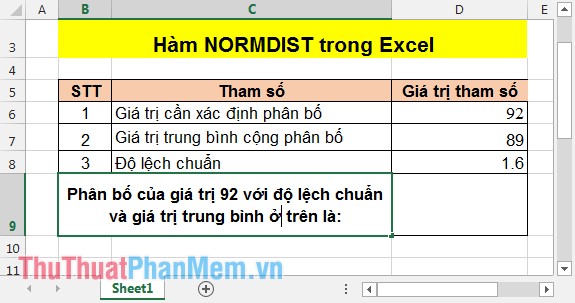
TH1: Cumulative value is TRUE
In the cell to calculate enter the formula: = NORMDIST (D6, D7, D8, TRUE) .
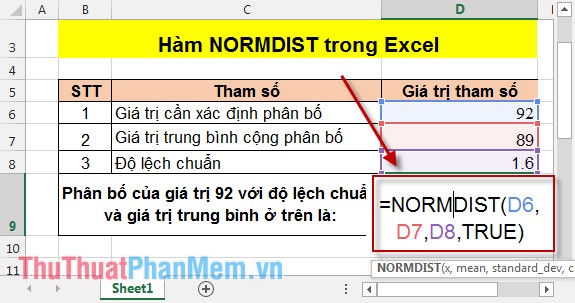
Pressing Enter has the result:
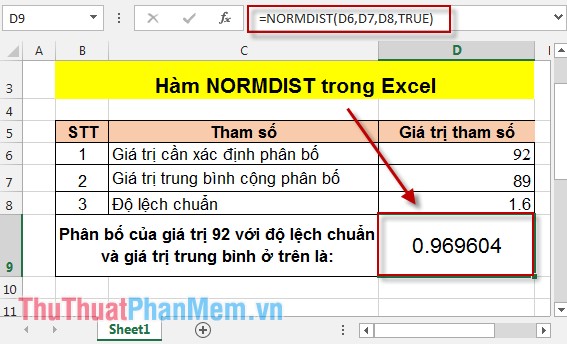
TH2: Cumulative value = FALSE
- In the cell to calculate, enter the formula: = NORMDIST (D6, D7, D8, FALSE) .

Pressing Enter results:
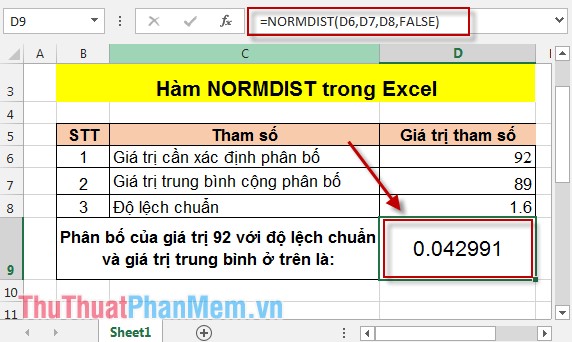
Case 3 : If the standard deviation = 1 and the mean value = 0, accumulate = True => NORMDIST (92) = NORMSDIST (92).
- NORMDIST function value (92):
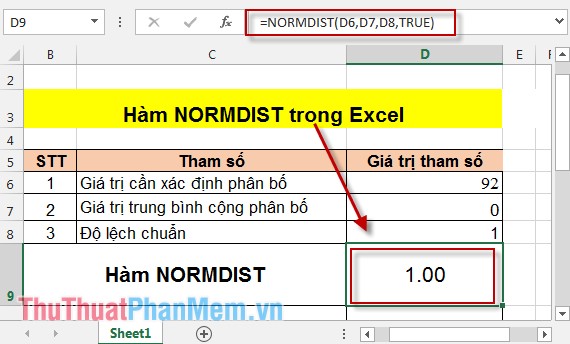
- NORMSDIST (92) value:
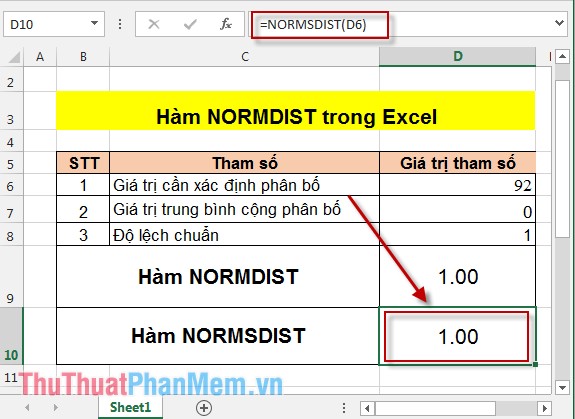
So if the standard deviation = 1 mean value = 0 and cumulative = true => NORMSDIST function is equal to the value of NORMDIST function.
The above details NORMDIST function and special case between NORMSDIST and NORMDIST functions. Hope this tool is helpful for you.
Good luck!
You should read it
- NORM.S.INV function - The function returns the inverse of the normalized distribution with an average value of 0 and a standard deviation of 1 in Excel
- NORM.S.DIST function - The function returns the normalized distribution with a mean of 0 and a standard deviation of 1 in Excel
- PHI function - The function returns the value of the density function for a normal distribution in Excel
- STDEV.P function - The function returns the standard deviation based on the whole in Excel
- SKEW function - The function returns the deviation of the distribution in Excel
- STDEV.S function - The function returns the standard deviation based on a sample in Excel
- NORM.INV function - The function returns the inverse of the standard cumulative distribution in Excel
- LOGNORM.INV function - The function returns the inverse of the logarithmic distribution of x in Excel
May be interested
- AVEDEV function - The function returns the average absolute deviation of data points from their midpoint in Excel
 avedev function: the function returns the average absolute deviation between a given data point and the average value of the population. the function is a measure of the variability of a dataset
avedev function: the function returns the average absolute deviation between a given data point and the average value of the population. the function is a measure of the variability of a dataset - WEIBULL function - The function returns the Weibull distribution in Excel
 the function performs the calculation and returns the weibull distribution. based on this distribution to analyze reliability in theory such as calculating the average life of the device or used in the field of meteorology, hydrology and weather forecast.
the function performs the calculation and returns the weibull distribution. based on this distribution to analyze reliability in theory such as calculating the average life of the device or used in the field of meteorology, hydrology and weather forecast. - LOGNORM.DIST - Function returns the logarithmic distribution of x in Excel
 lognorm.dist: the function returns the logarithmic distribution of x. where ln (x) is usually distributed with parameter mean and standard deviation. support functions from excel 2010 onwards. syntax: lognorm.dist (x, mean, standard_dev, cumulative)
lognorm.dist: the function returns the logarithmic distribution of x. where ln (x) is usually distributed with parameter mean and standard deviation. support functions from excel 2010 onwards. syntax: lognorm.dist (x, mean, standard_dev, cumulative) - How to use NORMDIST function in Excel
 normdist is a function that returns a distribution with a standard deviation and a confirmed average. the normdist function applies in statistics, including hypothesis testing.
normdist is a function that returns a distribution with a standard deviation and a confirmed average. the normdist function applies in statistics, including hypothesis testing. - NORMSDIST function - The function returns the normal cumulative distribution in Excel
 the following article details how to use the normsdist function - the function returns the cumulative normal distribution in excel.
the following article details how to use the normsdist function - the function returns the cumulative normal distribution in excel. - BINOM.INV function - The function returns the smallest value with cumulative binomial distribution greater or equal to the standard value in Excel
 binom.inv function: the function returns the smallest value with cumulative binomial distribution greater or equal to the standard value. support functions from the excel 2010 version. syntax: binom.inv (trials, probability_s, alpha)
binom.inv function: the function returns the smallest value with cumulative binomial distribution greater or equal to the standard value. support functions from the excel 2010 version. syntax: binom.inv (trials, probability_s, alpha) - GAMMA.INV function - The function returns the inverse of the gamma distribution in Excel
 gamma.inv: the function returns the inverse of the gamma distribution, using this function to study their distribution variables that may be symmetrical. support functions from excel 2010 onwards. syntax: gamma.inv (probability, alpha, beta)
gamma.inv: the function returns the inverse of the gamma distribution, using this function to study their distribution variables that may be symmetrical. support functions from excel 2010 onwards. syntax: gamma.inv (probability, alpha, beta) - GAMMA.DIST function - The function returns the gamma distribution in Excel
 gamma.dist: the function returns the gamma distribution, using this function to study skewed distribution variables. support functions from excel 2010 onwards. syntax: gamma.dist (x, alpha, beta, cumulative)
gamma.dist: the function returns the gamma distribution, using this function to study skewed distribution variables. support functions from excel 2010 onwards. syntax: gamma.dist (x, alpha, beta, cumulative) - CHIDIST function - Function returns the right end probability of the distribution when squared in Excel
 the following article introduces the chidist function - the function returns the right end probability of a distribution when the distribution helps you have a basis to determine the correctness of the expected with the original hypothesis.
the following article introduces the chidist function - the function returns the right end probability of a distribution when the distribution helps you have a basis to determine the correctness of the expected with the original hypothesis. - POISSON.DIST function - The function returns the Poisson distribution in Excel
 poisson.dist function: the function returns the poisson distribution, the application function to predict the number of events in a specific time. support functions from excel 2013 onwards. syntax: poisson.dist (x, mean, cumulative)
poisson.dist function: the function returns the poisson distribution, the application function to predict the number of events in a specific time. support functions from excel 2013 onwards. syntax: poisson.dist (x, mean, cumulative)










 SUBSTITUTE function - The function replaces text strings in Excel
SUBSTITUTE function - The function replaces text strings in Excel CHITEST function - The function returns the independence test in Excel
CHITEST function - The function returns the independence test in Excel ISPMT function - The function that calculates interest for a specified period in Excel
ISPMT function - The function that calculates interest for a specified period in Excel NORMINV function - The function returns the inverse of the cumulative distribution in Excel
NORMINV function - The function returns the inverse of the cumulative distribution in Excel QUARTILE function - The function returns the quartile of a dataset in Excel
QUARTILE function - The function returns the quartile of a dataset in Excel